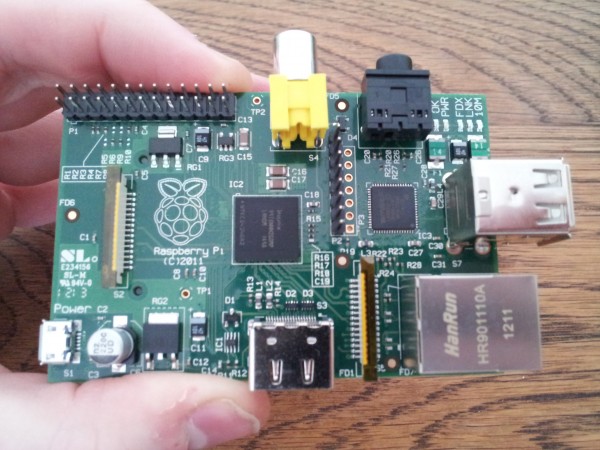I have in my hands, at last, a Raspberry Pi. No, not a delicious item of food, but a tiny, cheap computer designed to encourage people to learn how it works and make it do something new.
The Raspberry Pi has been brought into being by the Raspberry Pi Foundation, a charity who put their intentions like this:
We don’t claim to have all the answers. We don’t think that the Raspberry Pi is a fix to all of the world’s computing issues; we do believe that we can be a catalyst. We want to see cheap, accessible, programmable computers everywhere; we actively encourage other companies to clone what we’re doing. We want to break the paradigm where without spending hundreds of pounds on a PC, families can’t use the internet. We want owning a truly personal computer to be normal for children. We think that 2012 is going to be a very exciting year.
The people behind the idea want to address the lack of people studying for computer science degrees and they identified two problems which may cause this. One is that the way the computers (ICT) are taught in school is boring and business focused, teaching office skills and not computer science, and the other is that computers now are far more expensive and complex than those in the 80s, such as the BBC micro or the ZX Spectrum. Those computers, unlike the modern PC or Mac, encouraged tinkering, learning and extending.
I recommend that you watch this report from BBC Click which looks at the problem: Can a £15 computer solve the programming gap? [BBC Click]
To keep costs down, the Raspberry Pi uses an Arm processor - the same as in most mobile phones - and does not have very much memory. It is designed to connect to a TV so that an expensive monitor is not necessary. It uses the free Linux operating system which is also open to being modified by the end user. The intention is that simple programming software will be included with the Pi to enable someone to simply plug it in and start learning to write code. The copy of Linux which is recommended for the Raspberry Pi currently includes Scratch, which allows kids to create and animate “interactive stories, animations, games, music, and art” by dragging and dropping blocks of computer code.
The Raspberry Pi model B sells for approximately £30 once you add VAT and delivery and will be available from RS and from Element 14 / Farnell once they have the stock available. There will eventually be a Model A which will be a few pounds cheaper but will lack a network socket and will have only one USB socket. In addition to the Raspberry Pi itself you will need a memory card (SD card) to hold Linux, a keyboard and mouse with USB connectors, a power supply of the Micro USB sort used by many modern mobile phones, and access to a TV or monitor with a HDMI or a composite video connector. These may already be available but if not will add a few pounds to the cost.
At the moment the Raspberry Pi is mostly selling to hobbyists and enthusiasts rather than into education. That’s OK though; at the moment the software for the Pi requires quite a lot of experimentation and difficult-to-follow steps to make some things work and it isn’t really ready for prime time. Many of those people fortunate enough to get their hands on an early Raspberry Pi are working out the problems and feeding information back to everyone that will use one in the best tradition of open source software. By the time kids start to see these in schools in a few months there will hopefully be a lot more software ready to use without too much knowledge necessary.
Unless you already knew about the Raspberry Pi, you probably can’t have one at the moment. Interest in the Pi has been astonishingly high and I think that several hundred thousand people have placed pre-orders or signed up to reserve one. The initial batch was only ten thousand! I signed up for mine at 1 minute past 6 (am!) on the launch day three months ago and I have only just got one so new orders will take a few months yet.
Coming soon: I plan to write about getting started with the Raspberry Pi, what you need, and how to set it up and do something useful with it.
More Information
Can a £15 computer solve the programming gap? [BBC Click]
Computer programming at school [A Latent Existence]
Raspberry Pi: About Us [Raspberry Pi]


